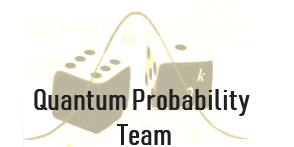Quantum Measurements
How to describe measurements and observable quantities inside quantum mechanics is a subject linked to foundations of quantum theories and a school on quantum measurement has been active in Milan since the sixties. Now this subject is becoming more and more important also for applications, mainly in quantum optics and in quantum information. Measurements of course make probabilities appear explicitly in quantum mechanics and so quantum measurement theory is an important topic in Quantum Probability. Our main topics of research are the following.
1. Quantum measurements in continuous time [BG09a, Ba06a, BG13b].
This is the case of continuous monitoring of a quantum system: one or more observables of a quantum system are followed with continuity in time. The statements of a quantum theory about an observable are of probabilistic nature; so, it is natural that a quantum theory of continuous measurements gives rise to stochastic processes. Moreover, a continuously observed system is certainly open. All these things show that the development and the applications of a quantum theory of continuous measurements needs quantum measurement theory, open system theory, quantum optics, operator theory, quantum probability, quantum and classical stochastic processes... There are essentially three approaches to continuous measurements.
- Operational approach.
This approach is based on positive operator valued measures or (generalized) observables and operation valued measures or instruments. Here quantum Markov semigroups are heavily involved and quantum analogs of the Lévy-Khinchin formula have been developed [BG09a, BP96b].
- Quantum stochastic differential equations.
The second approach is based on quantum stochastic calculus and quantum stochastic differential equations and it is connected to quantum Langevin equations and the notion of input and output fields in quantum optics [BG13b, BC11, BG08, Ba06a, Ba03, BL98, Ba96].
- Classical stochastic differential equations.
The last approach is based on classical stochastic differential equations (Markovian and non Markovian) and the notion of a posteriori states and it is related to filtering theory and to some notions appeared in quantum optics, such as quantum trajectories, Monte-Carlo wave function method, unraveling of master equation. The name of "quantum trajectory theory" is now used globally for this approach and the related notions [BG12, BP10, BG09a, BL04c, BP03, BP02, Ba01, BZ98, BPZ98, Ba96, BH95].
- Applications: photo-detection theory and optomechanical systems.
The main applications of continuous measurements are in quantum optics, where they give a way to formalize the various forms of photo-detection: direct detection and homodyne/heterodyne detection. Moreover, the use of the Hudson-Parthasarathy equation, the prototype of a QSDE, gives a flexible tool to model photoemissive sources and optomechanical systems [B16, BV15 Ba06a, BPe02, BL00, Ba99, BL98, Ba97, BP96a, Ba94, SP13].
- Applications: quantum control.
The quantum trajectory theory is suitable also to describe situations in which memory is important and in which measurement based feedback is used to control the system [SSBP14, BG13a, BG12, BPP12, BDPP11, BC10, BPP10, BG09b, BG09a, BGL09, BGL08].
2. Quantum Tomography.
Quantum Tomography is the branch of Quantum Physics aiming at detecting and reconstructing the unknown state of a quantum system by performing suitable measurements on it. In recent years, there has been a considerable interest in Quantum Tomography by means of incomplete measurements. Indeed, many properties of a quantum system can be captured without the complete reconstruction of the state, and their detection thus involves much less resources than full state tomography. In our work, we investigate which precisely are these properties. For each of them, we look for the minimal number of the needed measurements and the corresponding measurement set-ups. Now, quantum properties are simply subsets of states. When the latter are singleton sets, made by any state sharing some prior information (e.g., all pure states), this approach specializes to Quantum Tomography under prior information. In this framework, reconstructing the state from the statistics of an incomplete measurement is a very nontrivial task. Nonetheless, in some interesting cases we were able to develop reconstruction techniques and study their stability [CHST17, CHMST17, CHKaST16, CHKeST16, CHST15c, CHST15b, CHST15a, CHST14, CHT13, KS13].

